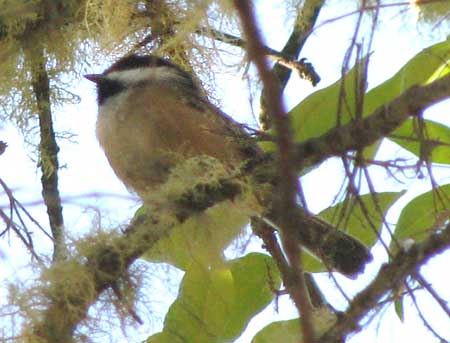Excerpts from Jim Conrad's
Naturalist Newsletter
from the September 27, 2009 Newsletter, issued from the Siskiyou Mountains west of Grants Pass, Oregon:
CHICKADEES AT THE RIVER
Instead of hiking into the mountains this week I descended into the valley and camped next to the pretty Rogue River. At only about 1000 feet in elevation (300 m) it was a little warmer there than here on the slope, and more sheltered, so I expected new plants and animals, and found some.
Away from the river's banks it was still very dry with few birds. Ospreys, Crows and Turkey Vultures silently winged up and down the river but inside the woods it remained eerily quiet. Therefore, when finally some chickadees began fussing from inside a drying-up ash tree I was tickled. Especially tickled because Oregon has three chickadee species -- the Black-capped, Mountain and Chestnut-backed -- and I wondered which one this was. You can see one of them in the ash below:

The Mountain Chickadee has two white head-stripes so it's not that one. The bird in the picture has a much rustier chest than is shown on either of the two remaining species in my old Robbins field guide. Moreover, some pictures on the Internet show both Black-caps and Chestnut-backs looking just like my picture.
As usual when I have Oregon bird-mysteries I sent the picture to my friend Romain, the best birder I know out here. You should hear how he can call Spotted Owls. Anyway, it turns out that about nine regional variations are recognized for Black-capped Chickadees and our Pacific Northwest race has buffy sides that can look a lot like the striking brown ones of a Chestnut-backed. In other words, he wasn't too sure who it was, either, but leaned toward Black-capped. He relayed the picture to Dennis, a local bird-bander who has handled plenty of birds up close.
"A Chestnut-backed would have a rich 'chestnut' color to the sides and belly would be much less colored, more grayish-brown making a sharp contrast," Dennis opined, adding that you don't see many whitish-bellied Black-caps in our area. He thought it probably was a Black-capped Chickadee, POECILE ATRICAPILLUS, but he wouldn't commit to it 100%.
So, let's say that with maybe 95% certainty the bird in the picture is the buff-breasted Pacific Northwest race of the Black-capped Chickadee, and isn't it interesting how even experts can have trouble with some of the most common birds?